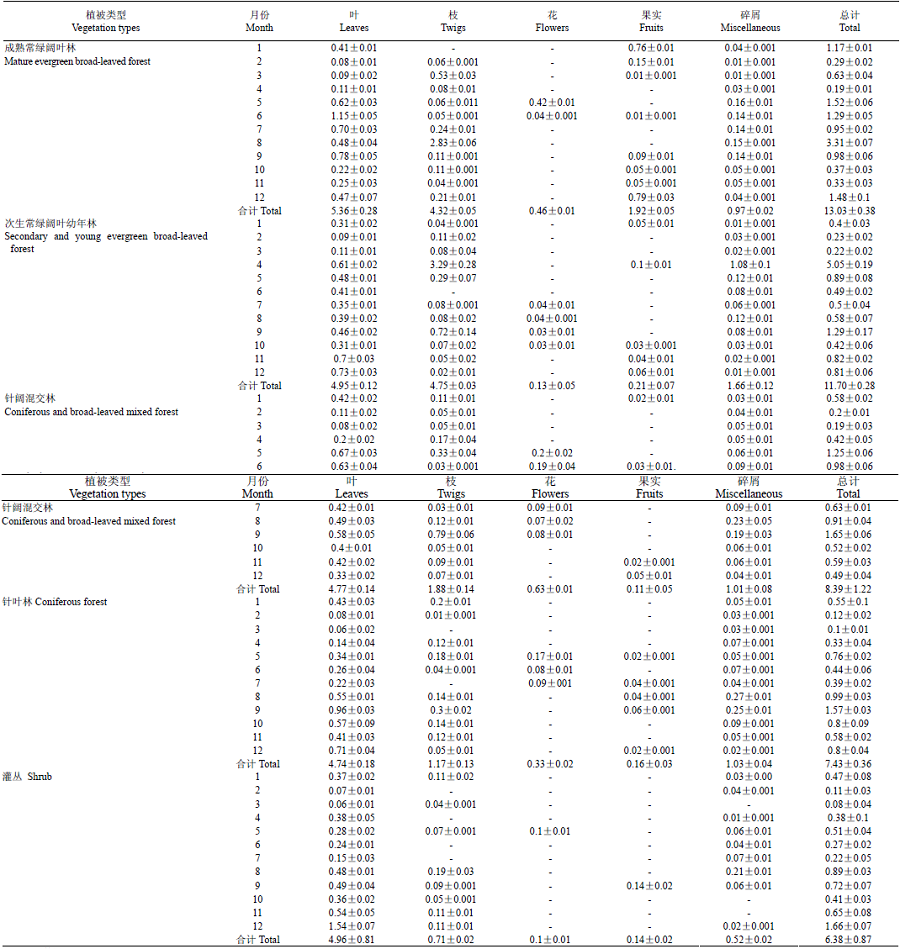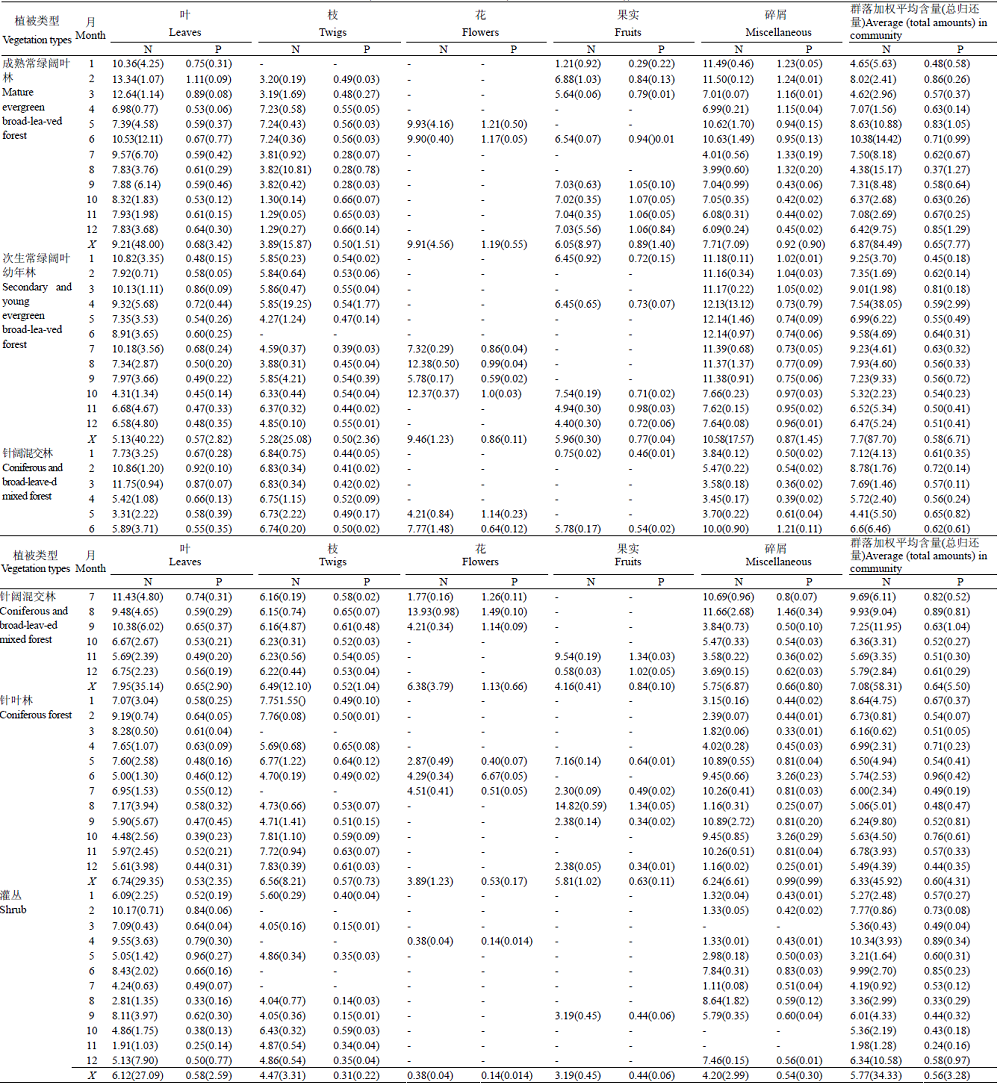

植物生态学报 ›› 2008, Vol. 32 ›› Issue (1): 1-12.DOI: 10.3773/j.issn.1005-264x.2008.01.001
• 论文 • 下一篇
收稿日期:2006-05-08
接受日期:2006-10-24
出版日期:2008-05-08
发布日期:2008-01-30
通讯作者:
阎恩荣
作者简介:E-mail: eryan@des.ecnu.edu.cn感谢李光耀、戴慧、赵亮、夏伟、王瑞、何东、姜良才、杨玲和高玉平同学在野外取样与室内分析工作中给予的帮助,感谢宋永昌教授、陈小勇教授与黄建军博士在论文写作上提出建议
基金资助:
YAN En-Rong( ), WANG Xi-Hua, ZHOU Wu
), WANG Xi-Hua, ZHOU Wu
Received:2006-05-08
Accepted:2006-10-24
Online:2008-05-08
Published:2008-01-30
Contact:
YAN En-Rong
摘要:
该研究以浙江天童常绿阔叶林及退化群落的凋落物特征为内容,探讨了养分归还和土壤养分动态之间的联系。结果显示:1)常绿阔叶林退化显著降低了凋落物的年凋落量,从成熟常绿阔叶林的13.03 Mg·hm-2下降到灌丛的6.38 Mg·hm-2。2)凋落物氮含量在成熟群落至灌丛阶段下降显著,而磷含量无明显递减规律;氮磷归还量均随常绿阔叶林退化显著下降。3)凋落物特征(年均值)与土壤养分的相关分析表明,土壤氮磷含量与凋落物凋落量间呈显著线性正相关;土壤氮含量与凋落物氮含量间无显著线性关系,而与氮归还量呈显著线性正相关(p<0.05);土壤总磷含量与凋落物磷含量和磷归还量间均呈显著线性正相关(磷含量: p<0.01; 磷归还量: p<0.001);土壤无机氮含量与凋落物各特征间无显著相关关系;土壤氮素硝化速率与凋落物凋落量和氮归还量间呈显著线性正相关(凋落物凋落量: p<0.01; 氮归还量: p<0.005),而与凋落物氮含量无显著线性关系,与之相比,土壤氮素矿化速率与凋落物特征间均不存在显著线性关系。可以认为,在常绿阔叶林退化过程中,由于不同植物在养分归还特征上的差异,导致了养分归还量的下降,从而使土壤养分库的物质来源减少,但是,群落结构简化而导致的非生物要素的改变,对控制土壤生物过程发挥着更大的作用。
阎恩荣, 王希华, 周武. 天童常绿阔叶林不同退化群落的凋落物特征及与土壤养分动态的关系. 植物生态学报, 2008, 32(1): 1-12. DOI: 10.3773/j.issn.1005-264x.2008.01.001
YAN En-Rong, WANG Xi-Hua, ZHOU Wu. CHARACTERISTICS OF LITTERFALL IN RELATION TO SOIL NUTRIENTS IN MATURE AND DEGRADED EVERGREEN BROAD-LEAVED FORESTS OF TIANTONG, EAST CHINA. Chinese Journal of Plant Ecology, 2008, 32(1): 1-12. DOI: 10.3773/j.issn.1005-264x.2008.01.001
| 植被类型 Vegetation types | 群落类型 Community types | 年龄 Age (a) | 海拔 Altitude (m) | 坡度 Slope | 坡向 Aspect | 群落高度 Height (m) | 总盖度 Coverage (%) | 主要优势种类 Dominant tree species | 干扰历史 Disturbance history |
|---|---|---|---|---|---|---|---|---|---|
| 成熟常绿阔叶林 Mature evergreen broad-leaved forest | 栲树群落 Castanopsis fargesii community | 150 | 196 | 26° | SE 45° | 25 | 90 | 栲树Castanopsis fargesii 木荷Schima superba 枫香Liquidambar formosana | 受保护 Protected from disturbance |
| 次生常绿阔叶幼年林 Secondary and young evergreen broad-leaved forest | 木荷群落 Schima superba community | 90 | 163 | 20° | SE 70° | 20 | 95 | 木荷Schima superba 石栎Lithocarpus glabra 马尾松Pinus massoniana | 废弃前有皆伐历史,废弃后自然更新 Clear-cut prior to abandonment, and then protected for natural regeneration |
| 针阔混交林 Coniferous and evergreen broad-leaved mixed forest | 马尾松+木荷群落 Pinus massoniana +Schima superba community | 70 | 121 | 5° | SE 45° | 15-20 | 95 | 马尾松Pinus massoniana 木荷Schima superba 栲树Castanopsis fargesii | |
| 针叶林 Coniferous forest | 马尾松群落 Pinus massoniana community | 60 | 135 | 15° | SE 10° | 16 | 95 | 马尾松Pinus massoniana 木荷Schima superba 枫香Liquidambar formosana | |
| 灌丛 Shrub | 石栎+ Lithocarpus glaber+ Loropetalum chinense community | 17 | 164 | 25° | SE 20° | 5 | 100 | 马尾松Pinus massoniana 木荷Schima superba 石栎Lithocarpus glabra | 薪炭林Fuel forest |
表1 浙江天童常绿阔叶林退化类型及其样地特征
Table 1 Degraded type of evergreen broad-leaved forests and characteristics of selected plots in Tiantong National Forest Park, East China
| 植被类型 Vegetation types | 群落类型 Community types | 年龄 Age (a) | 海拔 Altitude (m) | 坡度 Slope | 坡向 Aspect | 群落高度 Height (m) | 总盖度 Coverage (%) | 主要优势种类 Dominant tree species | 干扰历史 Disturbance history |
|---|---|---|---|---|---|---|---|---|---|
| 成熟常绿阔叶林 Mature evergreen broad-leaved forest | 栲树群落 Castanopsis fargesii community | 150 | 196 | 26° | SE 45° | 25 | 90 | 栲树Castanopsis fargesii 木荷Schima superba 枫香Liquidambar formosana | 受保护 Protected from disturbance |
| 次生常绿阔叶幼年林 Secondary and young evergreen broad-leaved forest | 木荷群落 Schima superba community | 90 | 163 | 20° | SE 70° | 20 | 95 | 木荷Schima superba 石栎Lithocarpus glabra 马尾松Pinus massoniana | 废弃前有皆伐历史,废弃后自然更新 Clear-cut prior to abandonment, and then protected for natural regeneration |
| 针阔混交林 Coniferous and evergreen broad-leaved mixed forest | 马尾松+木荷群落 Pinus massoniana +Schima superba community | 70 | 121 | 5° | SE 45° | 15-20 | 95 | 马尾松Pinus massoniana 木荷Schima superba 栲树Castanopsis fargesii | |
| 针叶林 Coniferous forest | 马尾松群落 Pinus massoniana community | 60 | 135 | 15° | SE 10° | 16 | 95 | 马尾松Pinus massoniana 木荷Schima superba 枫香Liquidambar formosana | |
| 灌丛 Shrub | 石栎+ Lithocarpus glaber+ Loropetalum chinense community | 17 | 164 | 25° | SE 20° | 5 | 100 | 马尾松Pinus massoniana 木荷Schima superba 石栎Lithocarpus glabra | 薪炭林Fuel forest |
 |
表2 天童地区常绿阔叶林及退化群落的凋落物组成、年际动态和年凋落量(t.hm-2)(平均值±标准方差(n=3))
Table 2 Composition, dynamics and annual amounts of litterfall in mature and degraded evergreen broad-leaved forests, Tiantong National Forest Park, East China (means±SD (n=3))
 |

图1 常绿阔叶林不同退化类型调落物的养分归还特征 数据为平均值(标准偏差)
Fig.1 Mean nutrient concentration and return amount via litterfall in mature and degraded evergreen broad-leaved forests Data are means (SD)
 |
表3 天童地区常绿阔叶林及退化群落的凋落物氮磷养分含量(g.kg-1)、归还量(kg.hm-2.month-1(或a-1))及季节动态(数据表示养分含量(养分归还量))
Table 3 Seasonal dynamics of nutrients content and return amount via litterfall in mature and degraded evergreen broad-leaved forests, Tiantong National Forest Park, East China(data are nutrients content (nutrient return amount))
 |
| 凋落物量 Litterfall biomass | 凋落物氮含量 N concentration in litterfall | 凋落物氮归还量 N amounts via litterfall | 凋落物磷含量 P concentration in litterfall | 凋落物磷归还量 P amounts via litterfall | |
|---|---|---|---|---|---|
| 土壤氮含量 Soil N concentration | 0.725, <0.01 | 0.071,0.801(ns) | 0.549, <0.05 | - | - |
| 土壤磷含量 Soil P concentration | 0.796, <0.001 | - | - | 0.706, <0.01 | 0.87, <0.000 1 |
| 土壤氨态氮含量 Soil N | -0.249,0.369(ns) | -0.443,0.098(ns) | -0.332,0.227(ns) | - | - |
| 土壤硝态氮含量 Soil NO3-N concentration | -0.147,0.601(ns) | -0.018,0.948(ns) | -0.146,0.603(ns) | - | - |
| 土壤有机氮硝化速率 Soil N nitrification rate | 0.671, <0.01 | 0.488,0.065(ns) | 0.630, <0.05 | - | - |
| 土壤有机氮矿化速率 Soil N mineralization rate | 0.489, 0.065(ns) | -0.171,0.542(ns) | 0.313, 0.256(ns) | - | - |
表4 常绿阔叶林不同退化群落凋落物特征与土壤养分动态的Pearson相关分析
Table 4 Pearson correlations between soil nutrients dynamics and litterfall in mature and degraded evergreen broad-leaved forests(r and p values, sample sizes n=15)
| 凋落物量 Litterfall biomass | 凋落物氮含量 N concentration in litterfall | 凋落物氮归还量 N amounts via litterfall | 凋落物磷含量 P concentration in litterfall | 凋落物磷归还量 P amounts via litterfall | |
|---|---|---|---|---|---|
| 土壤氮含量 Soil N concentration | 0.725, <0.01 | 0.071,0.801(ns) | 0.549, <0.05 | - | - |
| 土壤磷含量 Soil P concentration | 0.796, <0.001 | - | - | 0.706, <0.01 | 0.87, <0.000 1 |
| 土壤氨态氮含量 Soil N | -0.249,0.369(ns) | -0.443,0.098(ns) | -0.332,0.227(ns) | - | - |
| 土壤硝态氮含量 Soil NO3-N concentration | -0.147,0.601(ns) | -0.018,0.948(ns) | -0.146,0.603(ns) | - | - |
| 土壤有机氮硝化速率 Soil N nitrification rate | 0.671, <0.01 | 0.488,0.065(ns) | 0.630, <0.05 | - | - |
| 土壤有机氮矿化速率 Soil N mineralization rate | 0.489, 0.065(ns) | -0.171,0.542(ns) | 0.313, 0.256(ns) | - | - |
| [1] | Aerts R, Chapin FS Ⅲ (2000). The mineral nutrition of wild plants revisited: a re-evaluation of processes and patterns. Advances in Ecological Research, 30, 1-67. |
| [2] | Chapin FS Ⅲ, Matson PA, Mooney HA (2002). Principles of Terrestrial Ecosystem Ecology. Springer-Verlag, New York, 298. |
| [3] | Guan LL (官丽莉), Zhou GY (周国逸), Zhang DQ (张德强), Liu JX (刘菊秀), Zhang QM (张倩媚) (2004). Twenty years of litter fall dynamics in subtropical evergreen broad-leaved forests at the Dinghushan Forest Ecosystem Research Station. Acta Phytoecologica Sinica (植物生态学报), 28, 449-456. (in Chinese with English abstract) |
| [4] | Hǎttenschwiler S, Tiunov AV, Scheu S (2005). Biodiversity and litter decomposition in terrestrial ecosystems. Annual Review of Ecology, Evolution, and Systematics, 36, 191-218. |
| [5] | Mo JM (莫江明), Kong GH (孔国辉) (1997). Effects of litterfall and understory removal on soil N availability in a subtropical pine forest of China. Acta Ecologica Sinica (生态学报), 17, 109-112. (in Chinese with English abstract) |
| [6] | Mo JM (莫江明), Kong GH (孔国辉), Sandra B, Zhang YC (张佑昌) (2001). Litterfall response to human impacts in a Dinghushan pine forest. Acta Phytoecologica Sinica (植物生态学报), 25, 656-664. (in Chinese with English abstract) |
| [7] | Singh JS, Gupta SR (1997). Plant decomposition and soil respiration in terrestrial ecosystem. Botanical Review, 43, 449-528. |
| [8] | Song YC (宋永昌), Wang XR (王祥荣 (1995). Vegetation and Flora of Tiantong National Forest Park Zhejing Province (浙江天童国家森林公园的植被和区系), Shanghai Scientific and Technical Document Publishing House, Shanghai. (in Chinese) |
| [9] | Su B (苏波), Han XG (韩兴国), Qu CM (渠春梅), Li CG (李才贵) (2002). Factors affecting soil N availability in forest ecosystems: a literature review. Chinese Journal of Ecology (生态学杂志), 21(2), 40-46. (in Chinese with English abstract) |
| [10] | Wang XH (王希华), Huang JJ (黄建军), Yan ER (阎恩荣)(2004a). Leaf litter decomposition of common trees in Tiantong. Acta Phytoecologica Sinica (植物生态学报), 28, 457-467. (in Chinese with English abstract) |
| [11] | Wang XH (王希华), Huang JJ (黄建军), Yan ER (阎恩荣)(2004b). Study on leaf nutrient use efficiency of some trees in Tiantong National Forest Park. Chinese Journal of Ecology (生态学杂志) 23(4), 13-16. ( in Chinese with English abstract) |
| [12] | Wang XH (王希华), Huang JJ (黄建军), Yan ER (阎恩荣)(2004c). A study on leaf nutrient resorption of some trees in Tiantong National Forest Park. Guihaia (广西植物), 24, 81-85. (in Chinese with English abstract) |
| [13] |
Wardle DA, Bardgett RD, Klironomos JN, Setälä H, van der Putten WH, Wall DH (2004). Ecological linkages between aboveground and belowground biota. Science, 304, 1629-1633.
URL PMID |
| [14] | Weng H (翁轰), Li ZA (李志安), Tu MZ (屠梦照), Yao WH (姚文华) (1993). The production and nutrient contents of litter in forests of Ding Hu Shan Mountain. Acta Phytoecologica et Geobotanica Sinica (植物生态学与地植物学学报), 17, 299-304. (in Chinese with English abstract) |
| [15] | Yan ER (阎恩荣) (2006). Dynamics of Soil Nutrient Pools, Nutrient Use Strategies of Dominant Trees in Typical and Degraded Evergreen Broad-Leaved Forests (常绿阔叶林退化过程中土壤的养分库动态及植物的养分利用策略). PhD dissertation, East China Normal University, Shanghai, 29-49. (in Chinese with English abstract) |
| [16] | Yu MJ (于明坚), Chen QC (陈启王常), Li MH (李铭红), Chang J (常杰), Pan XD (潘晓东), Chen ZH (陈增红), Shao JB (邵剑波) (1996). Litterfall in the evergreen broad-leaved forests dominated by Cyclobalanopsis glauca in Zhejiang, SE China. Acta Phytoecologica Sinica (植物生态学报), 20, 144-150. (in Chinese with English abstract) |
| [17] | Zak DR, Holmes WE, White DC, Peacock AD, Tilman D (2003). Plant diversity, soil microbial communities, and ecosystem function: are there any links? Ecology, 84, 2042-2050. |
| [18] | Zhang DQ (张德强), Ye WH (叶万辉), Yu QF (余清发), Kong GH (孔国辉), Zhang YC (张佑倡) (2000). The litterfall of representative forests of successional series in Dinghushan. Acta Ecologica Sinica (生态学报), 20, 938-944. (in Chinese with English abstract) |
| [19] | Zhang QF (张庆费), Song YC (宋永昌), Wu HQ (吴化前), You WH (由文辉) (1999a). Dynamics of litter amount and it's decomposition in different succession stages of evergreen broad-leaved forest in Tiantong, Zhejiang Province. Acta Phytoecologica Sinica (植物生态学报), 23, 250-255. (in Chinese with English abstract) |
| [20] | Zhang QF (张庆费), Song YC (宋永昌), You WH (由文辉) (1999b). Relationship between plant community and secondary succession and soil fertility in Tiantong, Zhejiang Province. Acta Ecologica Sinica (生态学报), 19, 174-178. (in Chinese with English abstract) |
| [21] | Zheng Z (郑征), Li YR (李佑荣), Liu HM (刘宏茂), Feng ZL (冯志立), Gan JM (甘建民), Kong WJ (孔维静) (2005). Litterfall of tropical rainforests at different altitudes, Xishuangbanna, Southwest China. Acta Phytoecologica Sinica (植物生态学报), 29, 884-893. (in Chinese with English abstract) |
| [1] | 陈昭铨 王明慧 胡子涵 郎学东 何云琼 刘万德. 云南普洱季风常绿阔叶林幼苗群落构建机制[J]. 植物生态学报, 2024, 48(预发表): 0-0. |
| [2] | 龙吉兰 蒋铮 刘定琴 缪宇轩 周灵燕 冯颖 裴佳宁 刘瑞强 周旭辉 伏玉玲. 干旱下植物根系分泌物及其介导的根际激发效应研究进展[J]. 植物生态学报, 2024, 48(预发表): 0-0. |
| [3] | 仲琦, 李曾燕, 马炜, 况雨潇, 邱岭军, 黎蕴洁, 涂利华. 氮添加和凋落物处理对华西雨屏区常绿阔叶林凋落叶分解的影响[J]. 植物生态学报, 2023, 47(5): 629-643. |
| [4] | 李万年, 罗益敏, 黄则月, 杨梅. 望天树人工幼林混交对土壤微生物功能多样性与碳源利用的影响[J]. 植物生态学报, 2022, 46(9): 1109-1124. |
| [5] | 孙彩丽, 仇模升, 黄朝相, 王艺伟. 黔西南石漠化过程中土壤胞外酶活性及其化学计量变化特征[J]. 植物生态学报, 2022, 46(7): 834-845. |
| [6] | 朱玉荷, 肖虹, 王冰, 吴颖, 白永飞, 陈迪马. 蒙古高原草地不同深度土壤碳氮磷化学计量特征对气候因子的响应[J]. 植物生态学报, 2022, 46(3): 340-349. |
| [7] | 牟文博, 徐当会, 王谢军, 敬文茂, 张瑞英, 顾玉玲, 姚广前, 祁世华, 张龙, 苟亚飞. 排露沟流域不同海拔灌丛土壤碳氮磷化学计量特征[J]. 植物生态学报, 2022, 46(11): 1422-1431. |
| [8] | 毛瑾, 朵莹, 邓军, 程杰, 程积民, 彭长辉, 郭梁. 冬季增温和减雪对黄土高原典型草原土壤养分和细菌群落组成的影响[J]. 植物生态学报, 2021, 45(8): 891-902. |
| [9] | 朱华. 云南常绿阔叶林的植被地理研究[J]. 植物生态学报, 2021, 45(3): 224-241. |
| [10] | 胡琪娟, 盛茂银, 殷婕, 白义鑫. 西南喀斯特石漠化环境适生植物构树细根、根际土壤化学计量特征[J]. 植物生态学报, 2020, 44(9): 962-972. |
| [11] | 李帅锋, 郎学东, 黄小波, 王艳红, 刘万德, 徐崇华, 苏建荣. 云南普洱30 hm2季风常绿阔叶林动态监测样地群丛数量分类[J]. 植物生态学报, 2020, 44(3): 236-247. |
| [12] | 梅孔灿, 程蕾, 张秋芳, 林开淼, 周嘉聪, 曾泉鑫, 吴玥, 徐建国, 周锦容, 陈岳民. 不同植物来源可溶性有机质对亚热带森林土壤酶活性的影响[J]. 植物生态学报, 2020, 44(12): 1273-1284. |
| [13] | 陈禹含, 罗亦夫, 孙鑫晟, 魏冠文, 黄文军, 罗芳丽, 于飞海. 根部水淹和土壤养分提升对三峡库区消落带水蓼生长和繁殖特性的影响[J]. 植物生态学报, 2020, 44(11): 1184-1194. |
| [14] | 莫丹, 王振孟, 左有璐, 向双. 亚热带常绿阔叶林木本植物幼树阶段抽枝展叶的权衡关系[J]. 植物生态学报, 2020, 44(10): 995-1006. |
| [15] | 李军军, 李萌茹, 齐兴娥, 王立龙, 徐世健. 芨芨草叶片养分特征对氮磷不同添加水平的响应[J]. 植物生态学报, 2020, 44(10): 1050-1058. |
| 阅读次数 | ||||||
|
全文 |
|
|||||
|
摘要 |
|
|||||
Copyright © 2022 版权所有 《植物生态学报》编辑部
地址: 北京香山南辛村20号, 邮编: 100093
Tel.: 010-62836134, 62836138; Fax: 010-82599431; E-mail: apes@ibcas.ac.cn, cjpe@ibcas.ac.cn
备案号: 京ICP备16067583号-19